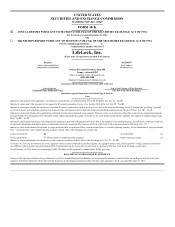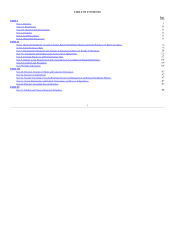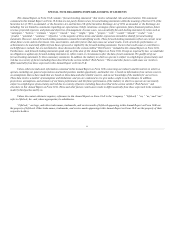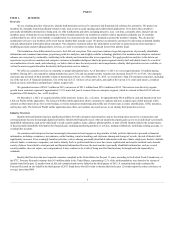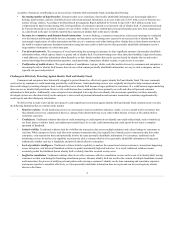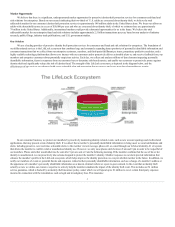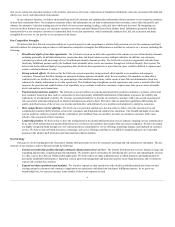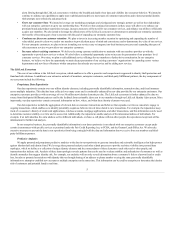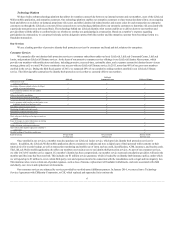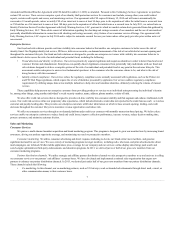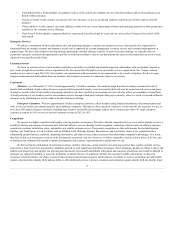LifeLock 2013 Annual Report Download - page 8
Download and view the complete annual report
Please find page 8 of the 2013 LifeLock annual report below. You can navigate through the pages in the report by either clicking on the pages listed below, or by using the keyword search tool below to find specific information within the annual report.
alerts flowing through the LifeLock ecosystem to reinforce the breadth and depth of our data and visibility into consumer behavior. We intend to
continue to enhance our algorithms to apply more sophisticated analytics to more types of consumer transactions and to detect potential identity
theft attempts more effectively and proactively.
•. We intend to leverage our marketing campaigns and existing and new strategic partners as well as the relationships
with our enterprise customers to grow our membership base. We believe that continued investments in these areas will allow us to enhance our
premium brand and product superiority message, increase awareness of the need for our consumer services, and enhance our ability to efficiently
acquire new members. We also intend to leverage the effectiveness of the LifeLock ecosystem to demonstrate to potential new enterprise customers
the benefits of becoming part of our ecosystem with the goal of expanding our enterprise customer base.
• . We plan to invest in increasing member retention by optimizing and expanding the number of
value-added, proactive alerts we send to our members to provide them peace of mind and convenience and to demonstrate the value of our services.
For our enterprise customers, we plan to invest in making our services easy to integrate into their business processes and expanding the types of
risk assessment services we provide to our enterprise customers.
• . We believe the strong customer satisfaction we maintain with our members provides us with the
opportunity to provide new services to them. We also believe a substantial opportunity exists to increase the penetration of our premium- level
consumer services. Over time, we plan to add additional service offerings for our members to further drive monetization. In our enterprise
business, we believe we have the opportunity to attain deeper penetration of our existing customers’ organizations by expanding across various
departments and new lines of business within enterprises that already use our service and by adding new services.
The core of our solution is the LifeLock ecosystem, which enables us to offer a proactive and comprehensive approach to identity theft protection and
fraud and risk solutions. In addition to our extensive network of members, enterprise customers, and third-party fulfillment partners, the key components of
our ecosystem include the following:
Our data repositories contain over one trillion identity elements, including personally identifiable information, transaction data, and fraud instances
across multiple industries. This data has been collected over many years and is continually enhanced by new data provided by our enterprise customers. Our
enterprise customers provide us with an average of over 50 million new identity elements per day. The LifeLock ecosystem is further enhanced by data we
source from third-party fulfillment partners and by the feedback from actionable alerts sent to our members through our LifeLock Identity Alert system. More
importantly, our data repositories contain contextual information on how, where, and when these identity elements were used.
Our data repositories include the aggregation of relevant data on consumer transactions and behavior that expands over time as consumers engage in
ongoing transactions, which enables us to identify potentially suspicious behavior in real time related to new transactions. For example, the repositories keep
track of a consumer’s history of credit card applications, wireless accounts, mortgage applications, and other transactions, and this information can be used
to determine customer stability over time and t o assess risk. Additionally, the repositories enable analysis of the interconnectedness of individuals. For
example, if an individual has the same address as five different individuals, or shares a cell phone with ten other people, the repositories keep track of this
information for further risk analysis.
In our enterprise business, the personally identifiable information in our data repositories is not shared with our enterprise customers except under
certain circumstances with specific services as permitted under the Fair Credit Reporting Act, or FCRA, and the Gramm-Leach-Bliley Act. We also take
extensive measures to prevent the data in our repositories from being comingled with the data and information that we receive from our members and third-
party fulfillment partners.
We apply patented and proprietary predictive analytics to the data in our repositories to generate immediate and actionable intelligence that helps protect
against identity theft and identity fraud. We leverage these patented analytics and other related processes to provide real-time visibility into personal data
topologies, which we define as a collection of unique identity elements and the connectedness of these elements to each other and to other people, and
transactions that indicate risk. Analysis of these data topologies reveals patterns that can be used to evaluate stability and authenticity of consumers as well as
identify anomalies that suggest identity risk. For example, our analytics will not only reveal information about a consumer’s link to a known fraud or credit
loss, but also to potential associations with identity thieves through sharing of an address or phone number or using the same personally identifiable
information to attempt to establish new accounts at multiple enterprises at the same time. This information can be used by enterprises to determine the identity
risk of customers and potential fraud in real time.
5

